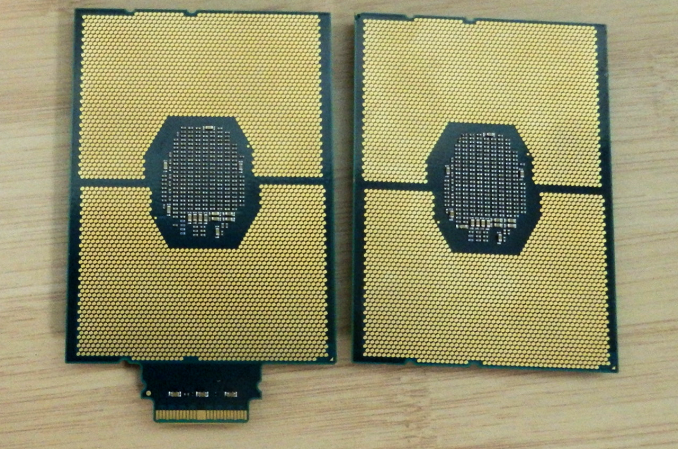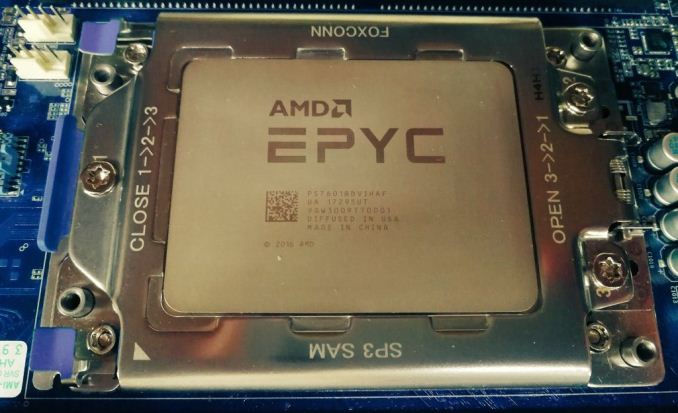Dissecting Intel's EPYC Benchmarks: Performance Through the Lens of Competitive Analysis
by Johan De Gelas & Ian Cutress on November 28, 2017 9:00 AM EST- Posted in
- CPUs
- AMD
- Intel
- Xeon
- Skylake-SP
- Xeon Platinum
- EPYC
- EPYC 7601
Conclusion
First of all, Intel's benchmarks lend further support to what we already suspected: Intel's Scalable Xeon is better at serving databases for a number of reasons: better data locality (fewer NUMA nodes), better single-threaded performance, and a more "useable" cache. The claim that Intel offers much more predictable database performance seems very reasonable to us: the EPYC platform is much younger and much more complex to tune as it is a "virtual 8 socket" system.
Secondly it is true that the Intel Scalable Xeon is more versatile: the past 5 years AMD's presence in the server market was neglible, while Intel has been steadily adding virtualization features (posted interrupts), I/O features and more (TSX for example). Many of these features are now supported by the hypervisor and OSes out there.
The EPYC platform has some catching up to do. Firmware updates and other software updates were necessary to run a hypervisor, and only relatively recent versions of the Linux kernel (February 2017 w/4.10+) have support for the EPYC processor. So even if we doubt that the 8160 can really deliver 37% better performance than the AMD EPYC in the real world, there is no denying that the Intel Xeon is a "safer bet" for VMware virtualization.
Nevertheless, it is interesting to see that Intel admits that there are quite a few use cases out there where AMD has an advantage. The AMD EPYC has a performance per dollar advantage in webserving and Java servers, for example.
Otherwise, there is some merit to the claim that AVX-512 allows Intel to offer excellent HPC performance without the use of a GPU in compute intensive applications. At the same time, if you are after the best performance on these very parallel workloads, a GPU almost always offers several times higher performance. AVX-512 can also not save Intel in several bandwidth-intensive benchmarks such, as in fluid dynamics.

Intel Xeon-SP CPUs (Left: with Omni-Path)
One interesting element to the whole scenario is that at no point does Intel ever approach the performance per watt angle in these discussions. It leaves a big question unanswered from Intel - perhaps we should invoke Hanlon's Razor at this point and call it a missed opportunity, rather than suggest that Intel does not want to speak about power. Our own results showed a win for AMD's EPYC here though, when comparing two 145W Xeon 8176 parts to two 180W EPYC 7601 parts. More testing on specific workloads is needed.
In summary, Intel makes several good points, even when those points aren't always in their own favor. The company clearly has an interest in ensuring that the Xeon's performance leadership remains well-known in light of AMD's EPYC-fueled resurgence, and while there's nothing altruistic about Intel's benchmarking, they are working from a sound position. Still, in defending their position – and by extension their high margins – Intel does highlight the Xeon's biggest weakness versus the EPYC in this newly competitive market: the Skylake Xeon can offer excellent performance, but that performance comes with an equally heavy price tag.

















105 Comments
View All Comments
Johan Steyn - Monday, December 18, 2017 - link
I have stated before that Anandtech is on Intel's payroll. You could see it especially with the first Threadripper review, it was horrendous to say the least. This article goes the same route. You see, two people can say the same thing, but project a completely different picture. I do not disagree that Intel has it strengths over EPYC, but this article basically just agrees with Intel,s presentation. Ha ha, that would have been funny, but it is not.Intel is corrupt company and Anandtech is missing the point on how they present their "facts." I now very rarely read anything Anandtech publishes. In the 90's they were excellent - those were the days...
Jumangi - Tuesday, November 28, 2017 - link
Maybe you have herd of Google..or Facebook. Not only d9 they build but they design their own rack systems to suit their massive needs.Samus - Wednesday, November 29, 2017 - link
Even mom and pop shops shouldn't have servers built from scratch. Who's going to support and validate that hardware for the long haul?HP and Dell have the best servers in my opinion. Top to bottom. Lenovo servers are at best just rehashes of their crappy workstations. If you want to get exotic (I don't) one could consider Supermicro...friends in the industry have always mentioned good luck with them, and good support. But my experience is with the big three.
Ratman6161 - Wednesday, November 29, 2017 - link
You are both wrong in my experience. These days the software that runs on servers usually costs more (often by a wide margin) than the hardware it runs on. I was once running a software package the company paid $320K for on a VM environment of five two socket Dell servers and a SAN where the total hardware cost was $165K. But that was for the whole VM environment that ran many other servers besides the two that ran this package. Even the $165K for the VM environment included VMWare licensing so that was part software too. Considering the resources the two VMs running this package used, the total cost for the project was probably somewhere around 10% hardware and 90% software licensing.For my particular usage, the virtualization numbers are the most important so if we accept these numbers, Intel seems to be the way to go. The $10K CPU's seem pretty outlandish though. For virtualization purposes it seems like there might be more bang for the buck by going with the 8160 and just adding more hosts. Would have to get down to actually doing the math to decide on that one.
meepstone - Thursday, December 7, 2017 - link
So I'm not sure who has the bigger e-peen between eek2121 and CajunArson. The drama in the comments were more entertaining than the article!ddriver - Tuesday, November 28, 2017 - link
Take a chill pill you intel shill :)Go over to servethehome and check results from someone who is not paid to pimp intel. Epyc enjoys ample lead against similarly priced xeons.
The only niche it is at a disadvantage is the low core count high clock speed skus, simply because for some inexplicable reason amd decided to not address that important market.
Lastly, nobody buys those 10+k $$$ xeons with his own money. Those are bought exclusively with "others' money" by people who don't care about purchase value, because they have deals with intel that put a percent of that money right back into their pockets, which is their true incentive. If they could put that money in their pockets directly, they would definitely seek the best purchase value rather than going through intel to essentially launder it for them.
iwod - Tuesday, November 28, 2017 - link
This. Go to servethehome and make up your own mind.lazarpandar - Tuesday, November 28, 2017 - link
It's one thing to sound like a dick, it's another thing to sound like a dick and be wrong at the same time.mkaibear - Tuesday, November 28, 2017 - link
Er, yes, if you want just 128Gb of RAM it may cost you $1,500, but if you actually want to use the capacity of those servers you'll want a good deal more than that.The server mentioned in the Intel example can take 1.5Tb of ECC RAM, at a total cost of about $20k - at which point the cost of the CPU is much less of an impact.
As CajunArson said, a full load of RAM on one of these servers is expensive. Your response of "yes well if you only buy 128Gb of RAM it's not that expensive", while true, is a tad asinine - you're not addressing the point he made.
eek2121 - Tuesday, November 28, 2017 - link
Not every workload requires that the RAM be topped off. We are currently in the middle of building our own private cloud on Hyper-V to replace our AWS presence, which involves building out at multiple datacenters around the country. Our servers have half a terabyte of RAM. Even with that much RAM, CPUs like this would still be (and are) a major factor in the overall cost of the server. The importance for our use case is the ability to scale, not the ability to cram as many VMs into one machine as possible. 2 servers with half a terabyte of RAM are far more valuable to us than 1 server with 1-1.5 terabytes due to redundancy.